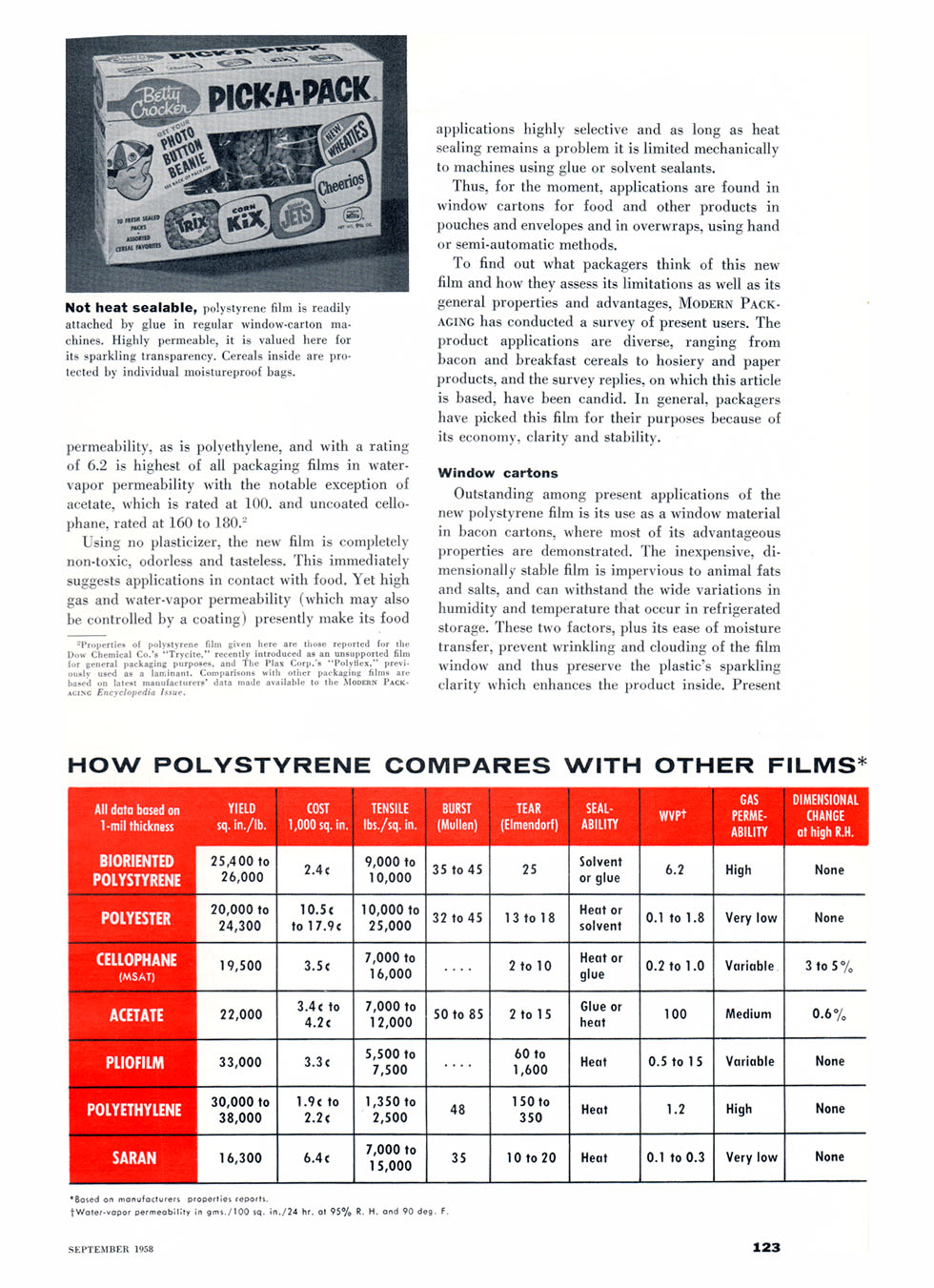


Not heat sealable? polystyrene film is readily attached by glue in regular window-carton machines. Highly permeable, it is valued here for its sparkling transparency. Cereals inside are protected by individual moistureproof bags.
permeability, as is polyethylene, and with a rating of 6.2 is highest of all packaging films in water-vapor permeability with the notable exception of acetate, which is rated at 100. and uncoated cellophane, rated at 160 to 180.2
Using no plasticizer, the new film is completely non-toxic, odorless and tasteless. This immediately suggests applications in contact with food. Yet high gas and water-vapor permeability (which may also be controlled by a coating) presently make its food
Properties of polystyrene film given here are those reported for the Dow Chemical Co.'s "Trycite,"ť recently introduced as an unsupported film for general packaging purposes, and The Plax Corp.'s "Polyfiex,"ť previously used as a laminant. Comparisons with other packaging films are based on latest manufacturers' data made available to the Modern Packaging Encyclopedia Issue.
applications highly selective and as long as heat sealing remains a problem it is limited mechanically to machines using glue or solvent sealants.
Thus, for the moment, applications are found in window cartons for food and other products in pouches and envelopes and in overwraps, using hand or semi-automatic methods.
To find out what packagers think of this new film and how they assess its limitations as well as its general properties and advantages, Modern Packaging has conducted a survey of present users. The product applications are diverse, ranging from bacon and breakfast cereals to hosiery and paper products, and the survey replies, on which this article is based, have been candid. In general, packagers have picked this film for their purposes because of its economy, clarity and stability.
Window cartons
Outstanding among present applications of the new polystyrene film is its use as a window material in bacon cartons, where most of its advantageous properties are demonstrated. The inexpensive, dimensionally stable film is impervious to animal fats and salts, and can withstand the wide variations in humidity and temperature that occur in refrigerated storage. These two factors, plus its ease of moisture transfer, prevent wrinkling and clouding of the film window and thus preserve the plastic's sparkling clarity which enhances the product inside. Present
HOW POLYSTYRENE COMPARES WITH OTHER FILMS*
|
All data based on 1-mil thickness |
YIELD sq. in./lb. |
COST 1,000 sq. in. |
TENSILE Ibs./sq. in. |
BURST (Mullen) |
TEAR (Elmendorf) |
SEAL- ABILITY |
WVP+ |
GAS PERME ABILITY |
DIMENSIONAL CHANGE at high R.H. |
|
BIORIENTED POLYSTYRENE |
25,400 to 26,000 |
2.4c |
9,000 to 1 0,000 |
35 to 45 |
25 |
Solvent or glue |
6.2 |
High |
None |
|
POLYESTER |
20,000 to 24,300 |
10.5c to 17.9c |
10,000 to 25,000 |
32 to 45 |
1 3 to 18 |
Heat or solvent |
0.1 to 1.8 |
Very low |
None |
|
CELLOPHANE (MSAT) |
19,500 |
3.5c |
7.000 to 16.000 |
2 to 10 |
Heat or glue |
0.2 to 1.0 |
Variable |
3 to 5% | |
|
ACETATE |
22,000 |
3.4c to 4.2c |
7.000 to 12.000 |
50 to 85 |
2 to 15 |
Glue or heat |
100 |
Medium |
0.6% |
|
PLIOFILM |
33,000 |
3.3c |
5,500 to 7,500 |
|
60 to 1,600 |
Heat |
0.5 to 15 |
Variable |
None |
|
POLYETHYLENE |
30,000 to 38,000 |
1.9c to 2.2c |
1,350 to 2,500 |
48 |
150 to 350 |
Heat |
1.2 |
High |
None |
|
SARAN |
16,300 |
6.4c _1 |
7,000 to 1 5,000 |
35 |
10 to 20 |
Heat |
0.1 to 0.3 |
Very low |
None |
*Based on manufacturers properties reports.
fWater-vapor permeability in 9ms./100 sq. in./24 hr. ot 95% R. H. and 90 deg. F.